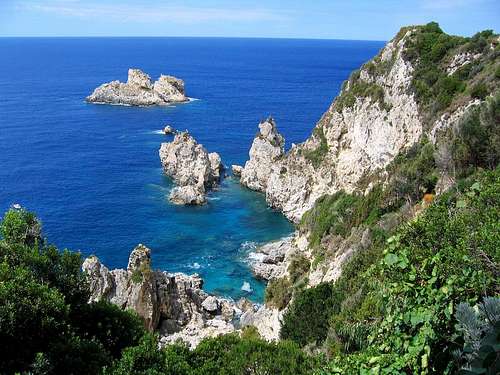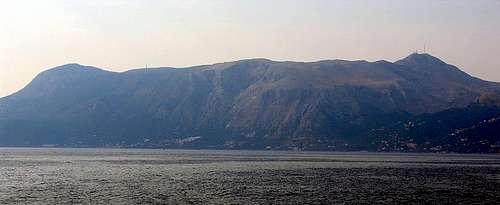|
|
Area/Range |
|---|---|
|
|
39.74806°N / 19.86500°E |
|
|
Mountaineering |
|
|
Spring |
|
|
3009 ft / 917 m |
|
|
Overview
The Ionian Islands - 'Heptanissa' or 'Seven Islands' - that is: Corfu, Zakynthos (Zante), Ithaca, Cepthalonia, Levkas (Lefkada) and Paxos, together with Cythera at the southernmost tip of the Peloponnese, make up one of the most attractive groups among the innumerable islands of sea-girt Greece. Verdant Corfu, the legendary island of the Phaeacians & Odysseus last stop on his way home to Ithaca, is the best known of these islands and one of the most beautiful, not only of Greece, but of the whole Mediterranean as well.
Corfu (Kerkyra) is one of the most visually exciting regions of Greece with its variety of natural beauty – green woodlands, wild pine-covered mountains, lakes, cultivated fields and of course, miles of golden beaches. The localised nature of development in the region leaves you free to choose your level of pleasure from rural simplicity to the very best in sophisticated services.
Corfu is the most northernmost and second largest (after Cephalonia) of the Ionian Islands. Its area covers 570 square kilometres and the length is 63 kilometres. Area: 570 square km / 229 square miles. Length: 63km / 35 miles; Width: 18 km / 11 miles
It is mountainous with the highest peak Pantokrator (917 m) located in north-eastern Corfu.
On Corfu island are placed several flat areas, the largest being the Ropa Valley. There are two lakes, Korission (south) and Antinioti (north), and four small rivers often dry in summer. Those are at Potamos (centre of the island), Sidari (north), Messogi and Lefkimmi (south).
Corfu was not given the name of the "Emerald Island" for no reason. Corfu, the wooded island of the Phaeacians, Odysseeus' last stop on his long journey home to to Ithica, is the greenest of all the Greek islands and the best known of the Ionian islands. Truly, how many civilizations, how many races have gone into producing what we see today. From the time when Odysseus was shipwrecked on Corfu, the island of Nausica, after his long journey from Troy to Ithaca, up today, Corinthians, Sicilians, Illyrians, and Romans all coveted this marvellous island. And later, in the Byzantine era, Goths, Normans, Franks, and Venetians, noblemen and pirates, kings and fortune hunters, all passed through Corfu and all left something to mark their passage.
Corfu is the bridge uniting Greece and the rest of Europe. The island of Corfu encapsulate the beauty of the Greek countryside and the nobility of Venetian architecture, the azure of the sea, the dark green of the cyprus trees, and the silver of the olives, the zest for life and the lyricism that all of the islanders possess. The traveller who, like Odysseeus, arrives in Corfu, will discover at every turn the sheer age of Europe. Ancient Greek monuments and Venetian fortresses, Byzantine churches and Neoclassical mansions, all in harmony with a unique landscape whose beauty has remained unchanged for thousands of years. Corfu, itself, owes its sophistication and charm to the meshing of the different civilisations that have occupied the island and to the natural beauty with which it is so abundantly endowed.
The prefecture of Corfu (Kerkyra) is situated in the Ionion Sea at 19'22E and 20'06E lat. and 39'96N and 39'54N long. It includes the island of Corfu, the islands of Paxos, Antipaxos and their smaller islets Discalia, Panayia and Exolithro all of which are found to the south of Corfu whilst the outlying islands, Othoni, Ericousa and Mathraki are situated to the northwest. The west coast of Othoni is also the westernmost point in the State of Greece.
Corfu is the seventh largest Greek island, and the second largest after Cephallonia of the Ionion islands.It is found in the north of the Ionion Sea, opposite the coastline of both Greece and Albania, separated by the Corfu Channel. Corfu itself has an area of 592,1 sq. km. and a coastline of 217 sq. km.
GEOLOGICAL STRUCTURE
The terrain is varied. In the north Mount Pantocrator rises to 917 m, in the centre smaller hills rise to 576 m, while in the south a series of hills ,not rising to more than 250 m, stretch down the island ending at the headland of Asprokavos (south) and Lefkimis (southeast).In no particular arrangement, large valleys dot the landscape , characteristically like the one around lake Korission situated close to the southwest coast.
CLIMATE
The island enjoys a mediterranean climate with mild winters and refreshing summers. However humidity is high owing to warm southwesterly winds (especially in the winter when winds can reach 8 Beaufort) and northwesterly winds (like the `maistro` of summer reaching force 4 Beaufort) causing heavy rainfall from time to time apart from the mid-summer months. The annual rainfall for Corfu (1,183mm) is the highest in Greece.
Average summer temperature: 28°C
Average winter temperature: 16°C
Wettest months: November / March
The relaxing but rich coutryside, the glorious beaches and many other wonderful sights have made Corfu one of the most beautiful islands in the Mediterranean and one of the most often-visited places in Greece.
POPULATION
It is the most densely populated area in Greece after great urban centres of Athens and Thessalonica. According to the latest census figures, the population of the island is 113.479 (2001) of which 41.048 (2001) inhabitants live in the town (Kerkyra).
Getting There
By Airplane
There are two type of flights that are available - Scheduled flights which are operated by Airline companies and can be booked direct with the Airline. To get to Corfu using scheduled flights you can fly to Athens and then get an internal flight from Athens to Corfu. Several airlines fly to Athens and Corfu and they are shown here. Scheduled flights fly all year and are the only way to get to Corfu by air in the winter months. You can also fly to Italy then travel to Corfu by ferry.
From Athens International Airport there are scheduled flights to Corfu several times a day. The trip takes an hour and costs around 100 €. There are also flights from Thessaloniki every Monday, Wednesday and Friday. There are charter flights from many European cities that go direct to Corfu during the summer.
By Bus & Ferry-Boat
From Athens to Igoumenitsa by bus, then from Igoumenitsa to Kerkyra or Lefkimi by Ferry-Boat.
There are daily departures from Athens Bus terminal (KTEL, 100 Kifissou str., Athens) to Corfu. Tickets are about 30 € and should be bought in advance if you want to be assured of a seat. The distance from Athens to Igoumenitsa is about 500 km and the trip lasts 7-8 hours.
From Igoumenitsa you must take the Ferry-Boat to Corfu Town or Lefkimi. The distance is 18 n.m., and the trip lasts 1h 45min and 1h 30min respectively. Tickets are about 4 € per persons and 30 € for Cars.
There are also daily departures from Salonica Bus terminal to Igoumenitsa. The trip from Salonica to Igoumenitsa lasts about 8 hours. Tickets are about 30€. From Igoumenitsa you must take the Ferry-Boat to Corfu Town or Lefkimi.
By Ferry-Boats
There are ferries every hour to and from Igoumounitsa on the mainland about an hour away. Most people get to Corfu by coming from Brindisi, Bari, Ancona, Trieste or Venice in Italy.
The trip from Brindisi is about 9 hours. Ancona is about 16 hours and Venice around 30 hours. There are several different ferry lines that compete. Most of the boats are pretty nice , especially the new ones owned by Strintzis, Superfast and Anek. These same boats continue on to Patras which takes 10 hours and then return. If you are going by deck then you can buy your ticket when you get to Italy. But if you want a cabin or have a car then it is best to book in advance.You can buy tickets leaving Corfu from any of the agencies on the Island.
How to get to Mt Pantokrator
1. Corfu town - Gouvia - Dassia - Ipsos - Spartilas - Sgourades - Strinilas - Mt Pantokrator (917 m)
2. Kassiopi - Acharavi - Agios Panteleimonas - Episkepsi - Sgourades - Strinilas - Mt Pantokrator (917 m)
To the summit of Pantokrator you can come also by car. On its summit you can see Pantokrator monastery. The mountain and monastery have the same name: Pantokrator means 'Protector of the Universe' and that's one of many Orthodox names of Jesus Christ.
Mt Pantokrator also offer good possibilities for mountainbiking. You can reach its summit driving on asphalt roads.
Camping
On Corfu island, belowe and around Mt Pantokrator (917 m) you can find many places for free camping. Nobody will disturb you.
Between Myth and History
The history of Corfu is checkered under a long succession of foreign rulers from Antiquity to 1884, when all the Ionian Islands were united with Greece. Romans, Venetians, French and British were all rulers of Corfu over the centuries. The marks of all those different people,their cultures, and their architectures can still be found today on the island. The town of Corfu (also called Kerkyra) is made up of completely dissimilar elements, left over from different civilisations. It presents an enchanting picture with its broad streets and spacious squares, the popular Spianada the town green contrasting with its narrow back alleys paved with blocks of stone (known as Kantounia), houses with a strong Italian influence, the famous Liston, a French arcade, traditional Georgian mansions, a Byzantine church, Venetian monuments, balconies with wrought-iron railings and window grilles.
Corfu's colorful history has been molded by its position in the Mediterranean Sea and the fertility of its fields. That is why visiting Corfu is like taking a trip back to the history and culture of Europe. Corfus natural beauty is hidden beneath a cloak of emerald green and a mountainous skyline that plunges into the bluest of blue waters. On this cosmopolitan island, youll be able to combine relaxation with good times and a full nightlife, for Corfu is an international tourist center, which can satisfy the demands of the most difficult visitor.
Tradition identifies Corfu as the Homeric Island of Scheria or the island where the Phaeacians hospitably received Odysseus on his return from Troy. It is also reputed to be the island where the Argonauts found refuge from the avenging Cholchic fleet after they had acquired the Golden Fleece. Both myths seem to stress the hospitality of the Phaeacians as well as the capability of their maritime skills.
The 'rudderless boat', which was established as the characteristic symbol of the island, is still used today.
CORFU HISTORY:
THE ROMAN REIGN 229 – 337 BC
EAST ROMAN REIGN 337 – 733 BC
THE BYZANTINE EMPIRE 733 – 1204
VENICE – THE FIRST PERIOD 1204-1214
THE SOVEREIGNTY OF IPIRUS 1214 – 1267
THE HOUSE OF ANJOU 1267 – 1386
THE VENETIAN STATE 1386-1797
THE DEMOCRATIC FRENCH 1797 – 1799
EPTANISOS, RUSSIANS – TURKS (1799 –1807)
THE IMPERIAL FRENCH 1807 – 1814
THE BRITISH 1814 – 1864
THE UNIFICATION OF EPTANISOS WITH GREECE (1864)
Map
On the Corfu Island you can find many maps of Corfu. Price: 3-5 Euro.
Red Tape
No extra fees.
























